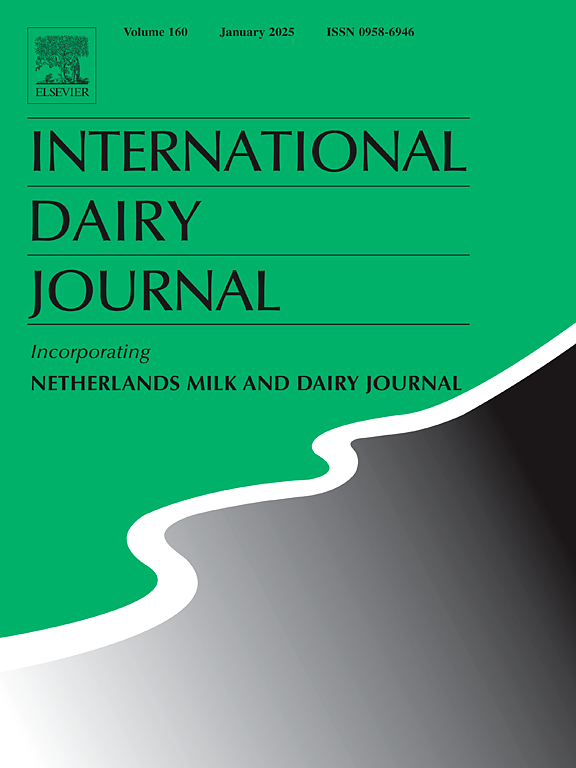柠檬酸盐与磷酸盐乳化盐配比对冲水发酵乳制奶酪类似物特性的影响
IF 3.4
3区 农林科学
Q2 FOOD SCIENCE & TECHNOLOGY
引用次数: 0
摘要
研究了柠檬酸三钠(TSC)与聚磷酸钠(SPP)的配比(3:1、2:1、1:1、1:2和1:3)对乳制品加工副产物水冲发酵乳(WFM)制成的类似奶酪的微观结构、质地、流变学和感官性能的影响。当TSC/SPP比例降至1:2时,奶酪类似物的质地和感官性能显著增强。在TSC/SPP为1:2时,干酪类似物具有最佳的硬度、弹性、咀嚼性、鲜味和可接受性,酪蛋白形成致密的三维网状结构。流变学分析进一步验证了TSC/SPP比为1:2的奶酪类似物具有稳定的凝胶体系和良好的粘弹性。然而,当TSC/SPP比为1:3时,由于过度乳化,奶酪类似物的性能下降。本研究表明,乳化盐对于以乳业副产品WFM为原料开发新型奶酪类似物至关重要,为乳制品加工废弃物的高价值利用提供了技术支持。本文章由计算机程序翻译,如有差异,请以英文原文为准。
Consequence of the ratio of citrate and phosphate emulsifying salts on the characteristics of cheese analogue made from water-flushing fermented milk
The consequence of the ratio of trisodium citrate (TSC) and sodium polyphosphate (SPP) (3:1, 2:1, 1:1, 1:2 and 1:3) on the microstructure, texture, rheological and sensory properties of cheese analogue made from water-flushing fermented milk (WFM), a by-product of dairy processing, was investigated. The texture and sensory properties of the cheese analogue was significantly enhanced with TSC/SPP ratio decreased to 1:2. At the ratio of TSC/SPP for 1:2, the cheese analogue had the optimal hardness, elasticity, chewiness, umami, and acceptability, while the casein formed dense three-dimensional network structure. Rheological analysis further verified that cheese analogue with TSC/SPP ratio of 1:2 had stable gel system and good viscoelasticity. However, after TSC/SPP ratio was 1:3, performance of the cheese analogue was weakened due to over-emulsification. This study exhibited that emulsifying salts were essential for the development of novel cheese analogues using dairy by-product WFM as raw material, providing the technical support for the high-value utilization of dairy processing wastes.
求助全文
通过发布文献求助,成功后即可免费获取论文全文。
去求助
来源期刊

International Dairy Journal
工程技术-食品科技
CiteScore
6.50
自引率
9.70%
发文量
200
审稿时长
49 days
期刊介绍:
The International Dairy Journal publishes significant advancements in dairy science and technology in the form of research articles and critical reviews that are of relevance to the broader international dairy community. Within this scope, research on the science and technology of milk and dairy products and the nutritional and health aspects of dairy foods are included; the journal pays particular attention to applied research and its interface with the dairy industry.
The journal''s coverage includes the following, where directly applicable to dairy science and technology:
• Chemistry and physico-chemical properties of milk constituents
• Microbiology, food safety, enzymology, biotechnology
• Processing and engineering
• Emulsion science, food structure, and texture
• Raw material quality and effect on relevant products
• Flavour and off-flavour development
• Technological functionality and applications of dairy ingredients
• Sensory and consumer sciences
• Nutrition and substantiation of human health implications of milk components or dairy products
International Dairy Journal does not publish papers related to milk production, animal health and other aspects of on-farm milk production unless there is a clear relationship to dairy technology, human health or final product quality.
 求助内容:
求助内容: 应助结果提醒方式:
应助结果提醒方式:


